2007 CHEVROLET AVEO brakes
[x] Cancel search: brakesPage 302 of 436
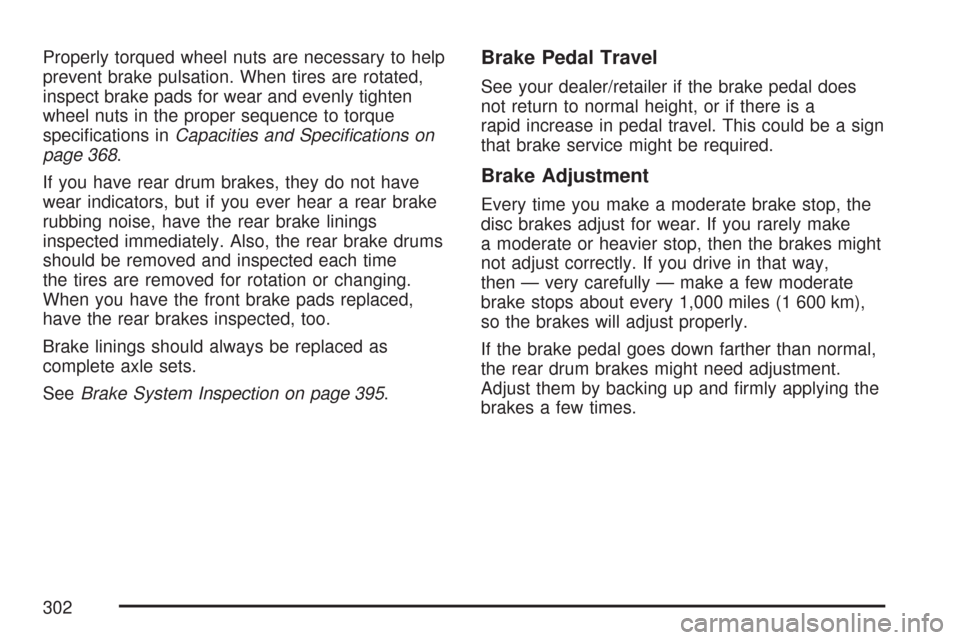
Properly torqued wheel nuts are necessary to help
prevent brake pulsation. When tires are rotated,
inspect brake pads for wear and evenly tighten
wheel nuts in the proper sequence to torque
specifications inCapacities and Specifications on
page 368.
If you have rear drum brakes, they do not have
wear indicators, but if you ever hear a rear brake
rubbing noise, have the rear brake linings
inspected immediately. Also, the rear brake drums
should be removed and inspected each time
the tires are removed for rotation or changing.
When you have the front brake pads replaced,
have the rear brakes inspected, too.
Brake linings should always be replaced as
complete axle sets.
SeeBrake System Inspection on page 395.Brake Pedal Travel
See your dealer/retailer if the brake pedal does
not return to normal height, or if there is a
rapid increase in pedal travel. This could be a sign
that brake service might be required.
Brake Adjustment
Every time you make a moderate brake stop, the
disc brakes adjust for wear. If you rarely make
a moderate or heavier stop, then the brakes might
not adjust correctly. If you drive in that way,
then — very carefully — make a few moderate
brake stops about every 1,000 miles (1 600 km),
so the brakes will adjust properly.
If the brake pedal goes down farther than normal,
the rear drum brakes might need adjustment.
Adjust them by backing up and firmly applying the
brakes a few times.
302
Page 303 of 436
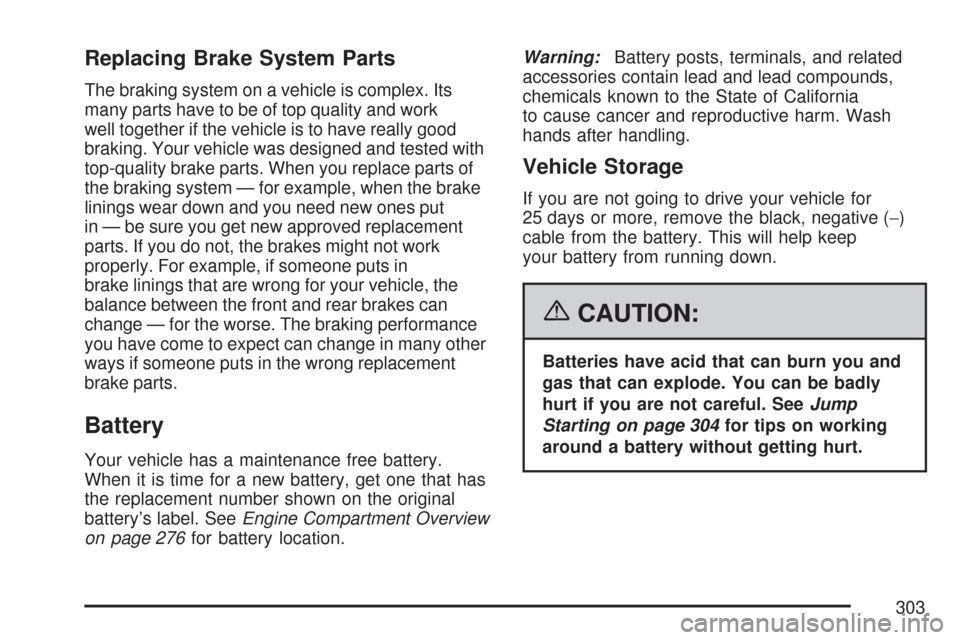
Replacing Brake System Parts
The braking system on a vehicle is complex. Its
many parts have to be of top quality and work
well together if the vehicle is to have really good
braking. Your vehicle was designed and tested with
top-quality brake parts. When you replace parts of
the braking system — for example, when the brake
linings wear down and you need new ones put
in — be sure you get new approved replacement
parts. If you do not, the brakes might not work
properly. For example, if someone puts in
brake linings that are wrong for your vehicle, the
balance between the front and rear brakes can
change — for the worse. The braking performance
you have come to expect can change in many other
ways if someone puts in the wrong replacement
brake parts.
Battery
Your vehicle has a maintenance free battery.
When it is time for a new battery, get one that has
the replacement number shown on the original
battery’s label. SeeEngine Compartment Overview
on page 276for battery location.Warning:Battery posts, terminals, and related
accessories contain lead and lead compounds,
chemicals known to the State of California
to cause cancer and reproductive harm. Wash
hands after handling.
Vehicle Storage
If you are not going to drive your vehicle for
25 days or more, remove the black, negative (−)
cable from the battery. This will help keep
your battery from running down.
{CAUTION:
Batteries have acid that can burn you and
gas that can explode. You can be badly
hurt if you are not careful. SeeJump
Starting on page 304for tips on working
around a battery without getting hurt.
303
Page 323 of 436
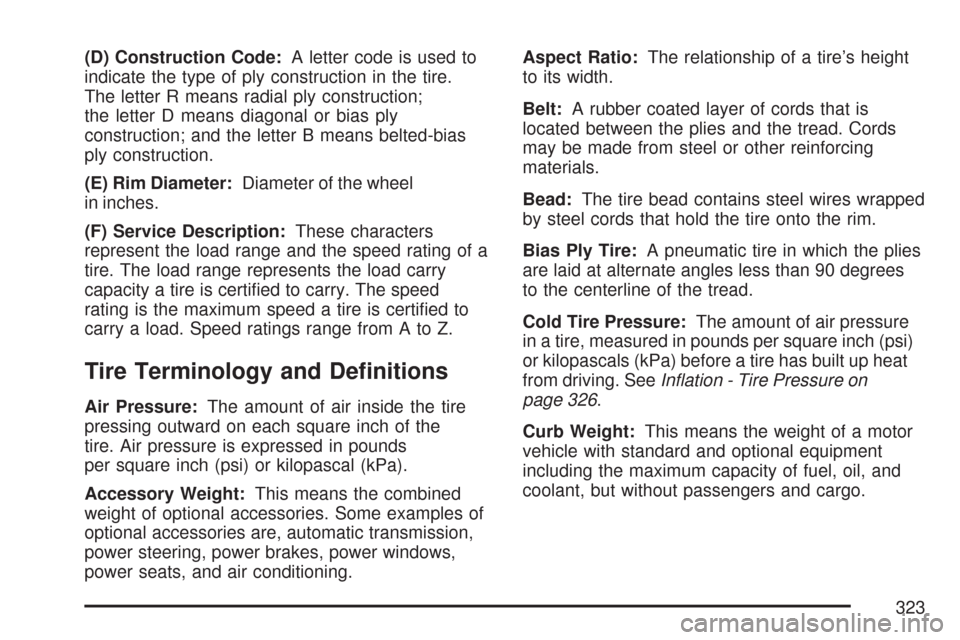
(D) Construction Code:A letter code is used to
indicate the type of ply construction in the tire.
The letter R means radial ply construction;
the letter D means diagonal or bias ply
construction; and the letter B means belted-bias
ply construction.
(E) Rim Diameter:Diameter of the wheel
in inches.
(F) Service Description:These characters
represent the load range and the speed rating of a
tire. The load range represents the load carry
capacity a tire is certified to carry. The speed
rating is the maximum speed a tire is certified to
carry a load. Speed ratings range from A to Z.
Tire Terminology and De�nitions
Air Pressure:The amount of air inside the tire
pressing outward on each square inch of the
tire. Air pressure is expressed in pounds
per square inch (psi) or kilopascal (kPa).
Accessory Weight:This means the combined
weight of optional accessories. Some examples of
optional accessories are, automatic transmission,
power steering, power brakes, power windows,
power seats, and air conditioning.Aspect Ratio:The relationship of a tire’s height
to its width.
Belt:A rubber coated layer of cords that is
located between the plies and the tread. Cords
may be made from steel or other reinforcing
materials.
Bead:The tire bead contains steel wires wrapped
by steel cords that hold the tire onto the rim.
Bias Ply Tire:A pneumatic tire in which the plies
are laid at alternate angles less than 90 degrees
to the centerline of the tread.
Cold Tire Pressure:The amount of air pressure
in a tire, measured in pounds per square inch (psi)
or kilopascals (kPa) before a tire has built up heat
from driving. SeeInflation - Tire Pressure on
page 326.
Curb Weight:This means the weight of a motor
vehicle with standard and optional equipment
including the maximum capacity of fuel, oil, and
coolant, but without passengers and cargo.
323
Page 331 of 436
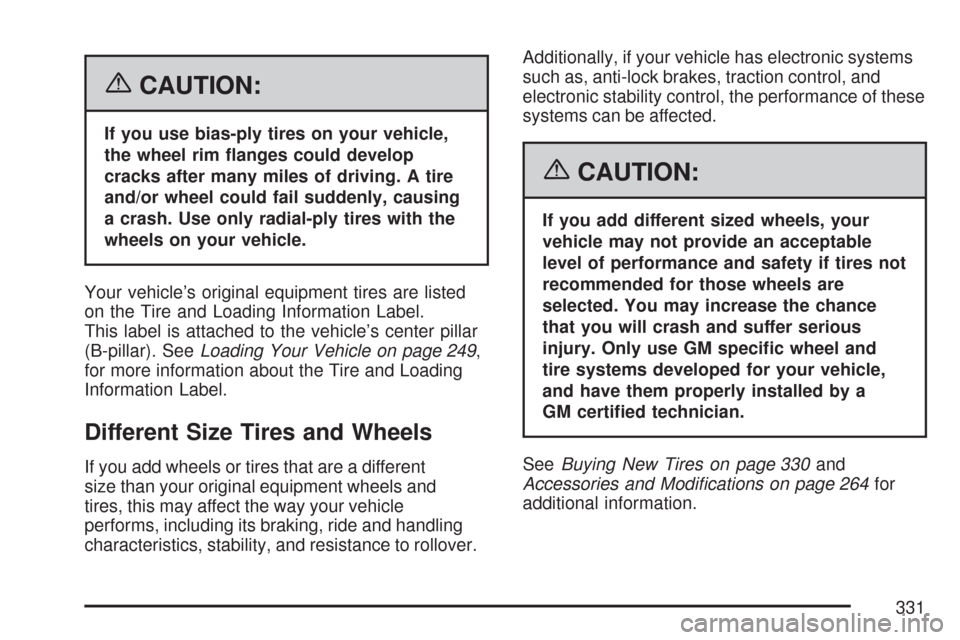
{CAUTION:
If you use bias-ply tires on your vehicle,
the wheel rim �anges could develop
cracks after many miles of driving. A tire
and/or wheel could fail suddenly, causing
a crash. Use only radial-ply tires with the
wheels on your vehicle.
Your vehicle’s original equipment tires are listed
on the Tire and Loading Information Label.
This label is attached to the vehicle’s center pillar
(B-pillar). SeeLoading Your Vehicle on page 249,
for more information about the Tire and Loading
Information Label.
Different Size Tires and Wheels
If you add wheels or tires that are a different
size than your original equipment wheels and
tires, this may affect the way your vehicle
performs, including its braking, ride and handling
characteristics, stability, and resistance to rollover.Additionally, if your vehicle has electronic systems
such as, anti-lock brakes, traction control, and
electronic stability control, the performance of these
systems can be affected.
{CAUTION:
If you add different sized wheels, your
vehicle may not provide an acceptable
level of performance and safety if tires not
recommended for those wheels are
selected. You may increase the chance
that you will crash and suffer serious
injury. Only use GM speci�c wheel and
tire systems developed for your vehicle,
and have them properly installed by a
GM certi�ed technician.
SeeBuying New Tires on page 330and
Accessories and Modifications on page 264for
additional information.
331
Page 377 of 436
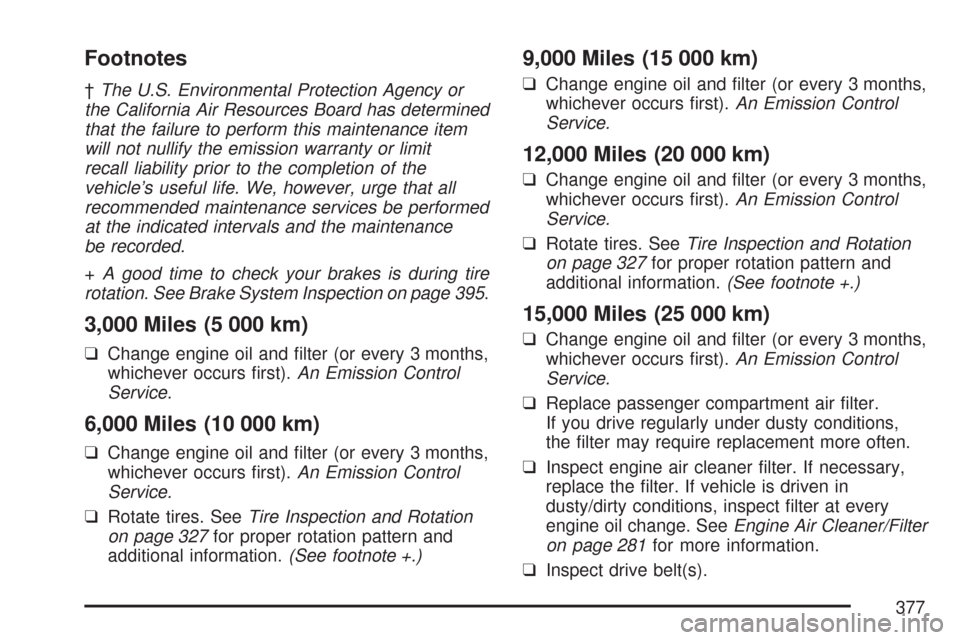
Footnotes
†The U.S. Environmental Protection Agency or
the California Air Resources Board has determined
that the failure to perform this maintenance item
will not nullify the emission warranty or limit
recall liability prior to the completion of the
vehicle’s useful life. We, however, urge that all
recommended maintenance services be performed
at the indicated intervals and the maintenance
be recorded.
+A good time to check your brakes is during tire
rotation. See Brake System Inspection on page 395.
3,000 Miles (5 000 km)
❑Change engine oil and filter (or every 3 months,
whichever occurs first).An Emission Control
Service.
6,000 Miles (10 000 km)
❑Change engine oil and filter (or every 3 months,
whichever occurs first).An Emission Control
Service.
❑Rotate tires. SeeTire Inspection and Rotation
on page 327for proper rotation pattern and
additional information.(See footnote +.)
9,000 Miles (15 000 km)
❑Change engine oil and filter (or every 3 months,
whichever occurs first).An Emission Control
Service.
12,000 Miles (20 000 km)
❑Change engine oil and filter (or every 3 months,
whichever occurs first).An Emission Control
Service.
❑Rotate tires. SeeTire Inspection and Rotation
on page 327for proper rotation pattern and
additional information.(See footnote +.)
15,000 Miles (25 000 km)
❑Change engine oil and filter (or every 3 months,
whichever occurs first).An Emission Control
Service.
❑Replace passenger compartment air filter.
If you drive regularly under dusty conditions,
the filter may require replacement more often.
❑Inspect engine air cleaner filter. If necessary,
replace the filter. If vehicle is driven in
dusty/dirty conditions, inspect filter at every
engine oil change. SeeEngine Air Cleaner/Filter
on page 281for more information.
❑Inspect drive belt(s).
377
Page 384 of 436
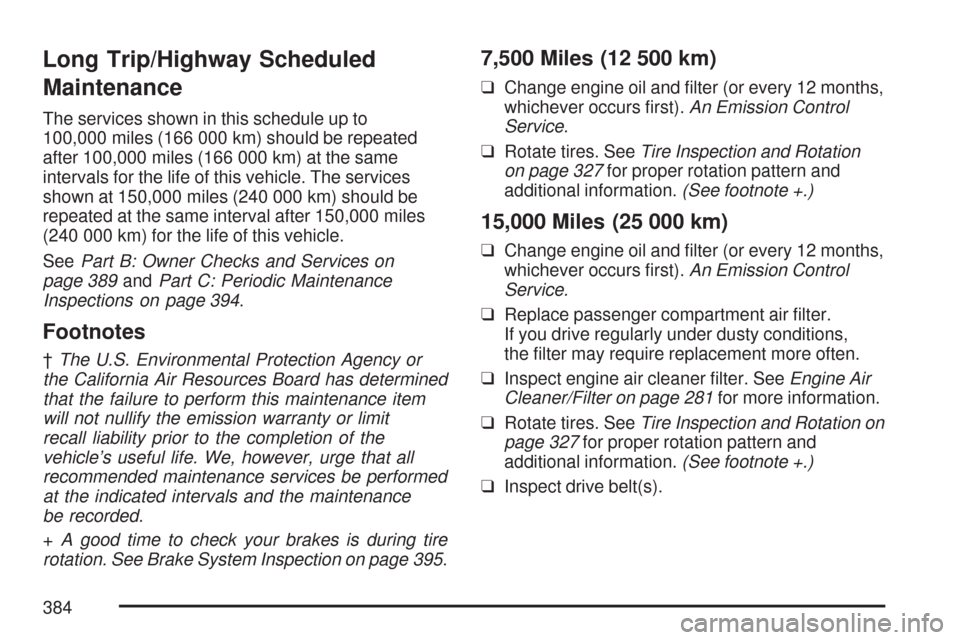
Long Trip/Highway Scheduled
Maintenance
The services shown in this schedule up to
100,000 miles (166 000 km) should be repeated
after 100,000 miles (166 000 km) at the same
intervals for the life of this vehicle. The services
shown at 150,000 miles (240 000 km) should be
repeated at the same interval after 150,000 miles
(240 000 km) for the life of this vehicle.
SeePart B: Owner Checks and Services on
page 389andPart C: Periodic Maintenance
Inspections on page 394.
Footnotes
†The U.S. Environmental Protection Agency or
the California Air Resources Board has determined
that the failure to perform this maintenance item
will not nullify the emission warranty or limit
recall liability prior to the completion of the
vehicle’s useful life. We, however, urge that all
recommended maintenance services be performed
at the indicated intervals and the maintenance
be recorded.
+A good time to check your brakes is during tire
rotation. See Brake System Inspection on page 395.
7,500 Miles (12 500 km)
❑Change engine oil and filter (or every 12 months,
whichever occurs first).An Emission Control
Service.
❑Rotate tires. SeeTire Inspection and Rotation
on page 327for proper rotation pattern and
additional information.(See footnote +.)
15,000 Miles (25 000 km)
❑Change engine oil and filter (or every 12 months,
whichever occurs first).An Emission Control
Service.
❑Replace passenger compartment air filter.
If you drive regularly under dusty conditions,
the filter may require replacement more often.
❑Inspect engine air cleaner filter. SeeEngine Air
Cleaner/Filter on page 281for more information.
❑Rotate tires. SeeTire Inspection and Rotation on
page 327for proper rotation pattern and
additional information.(See footnote +.)
❑Inspect drive belt(s).
384
Page 395 of 436
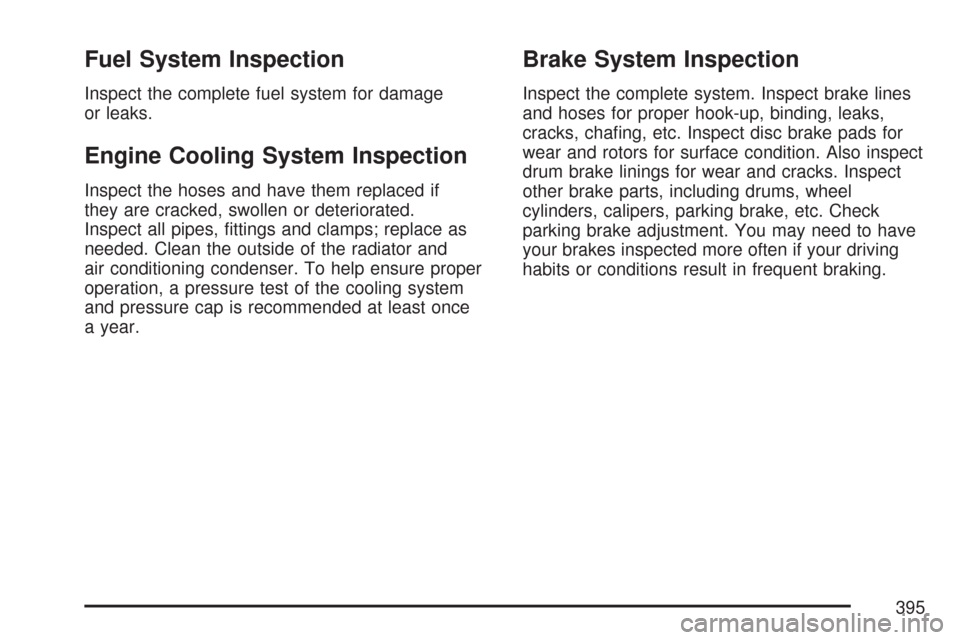
Fuel System Inspection
Inspect the complete fuel system for damage
or leaks.
Engine Cooling System Inspection
Inspect the hoses and have them replaced if
they are cracked, swollen or deteriorated.
Inspect all pipes, fittings and clamps; replace as
needed. Clean the outside of the radiator and
air conditioning condenser. To help ensure proper
operation, a pressure test of the cooling system
and pressure cap is recommended at least once
a year.
Brake System Inspection
Inspect the complete system. Inspect brake lines
and hoses for proper hook-up, binding, leaks,
cracks, chafing, etc. Inspect disc brake pads for
wear and rotors for surface condition. Also inspect
drum brake linings for wear and cracks. Inspect
other brake parts, including drums, wheel
cylinders, calipers, parking brake, etc. Check
parking brake adjustment. You may need to have
your brakes inspected more often if your driving
habits or conditions result in frequent braking.
395
Page 420 of 436

In Canada, please call us at 1-800-263-3777
(English) or 1-800-263-7854 (French). Or, write:
General Motors of Canada Limited
Customer Communication Centre, CA1-163-005
1908 Colonel Sam Drive
Oshawa, Ontario L1H 8P7
Service Publications Ordering
Information
Service Manuals
Service Manuals have the diagnosis and repair
information on engines, transmission, axle
suspension, brakes, electrical, steering, body, etc.
Transmission, Transaxle, Transfer
Case Unit Repair Manual
This manual provides information on unit repair
service procedures, adjustments, and
specifications for GM transmissions, transaxles,
and transfer cases.
Service Bulletins
Service Bulletins give technical service information
needed to knowledgeably service General
Motors cars and trucks. Each bulletin contains
instructions to assist in the diagnosis and service
of your vehicle.
In Canada, the service bulletin reference number
can be obtained by contacting your General
Motors dealer or by calling 1-800-GM-DRIVE
(1-800-463-7483). This reference number is
needed to order the service bulletin from
Helm, Inc.
RETAIL SELL PRICE: $6.00 US + Processing Fee
420